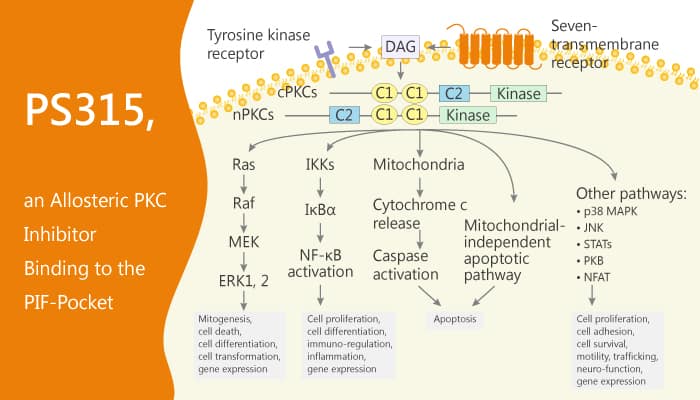Members of the protein kinase C (PKC) family are regulated by phosphorylation and by an N-terminal extension of the catalytic domain. In addition, AGC kinases are a group of protein kinases comprising PKA, protein kinase G, and PKC families. They typically have three conserved phosphorylation sites. Besides, all PKCs contains a pseudosubstrate region (PSR) and a contiguous C1 domain. Moreover, conventional PKCs have two C1 domains and one C2 domain, novel PKCs possess two C1 domains and one novel C2 domain. Atypical PKC isoforms play an important role in cellular polarization. Furthermore, helix αC acts as a key mediator of aPKC mechanism of inhibition by the N-terminal domains. Finally, the PIF-pocket is a specific binding site for small compounds that allosterically inhibit aPKCs. PS315 is an allosteric PKC inhibitor by binding to the PIF-pocket of aPKC and inducing displacement of the active site residue Lys111.

PS315 is an allosteric PKC inhibitor by binding to the PIF-pocket of aPKC and inducing displacement of the active site residue Lys111. Specifically, PS315 inhibits the full-length and catalytic domain constructs of PKCζ and PKCη. Meanwhile, PS315 is a derivative of PS48 and has anti-cancer activity. Nonetheless, PS315 exploits the physiological dynamics of helix αC for its binding and allosteric inhibition. The small allosteric inhibitor PS315 and the N-terminal region of aPKC both act directly on the PIF-pocket on-off switch. Additionally, PS315 induces a displacement of the active site residue Lys111, thereby inhibiting the activity of aPKCs by allosterically affecting the catalytic mechanism of the kinase. All in all, PS315 is an allosteric PKC inhibitor with anti-cancer activity.
References:
Zhang H, et al. Chem Biol. 2014 Jun 19;21(6):754-65.